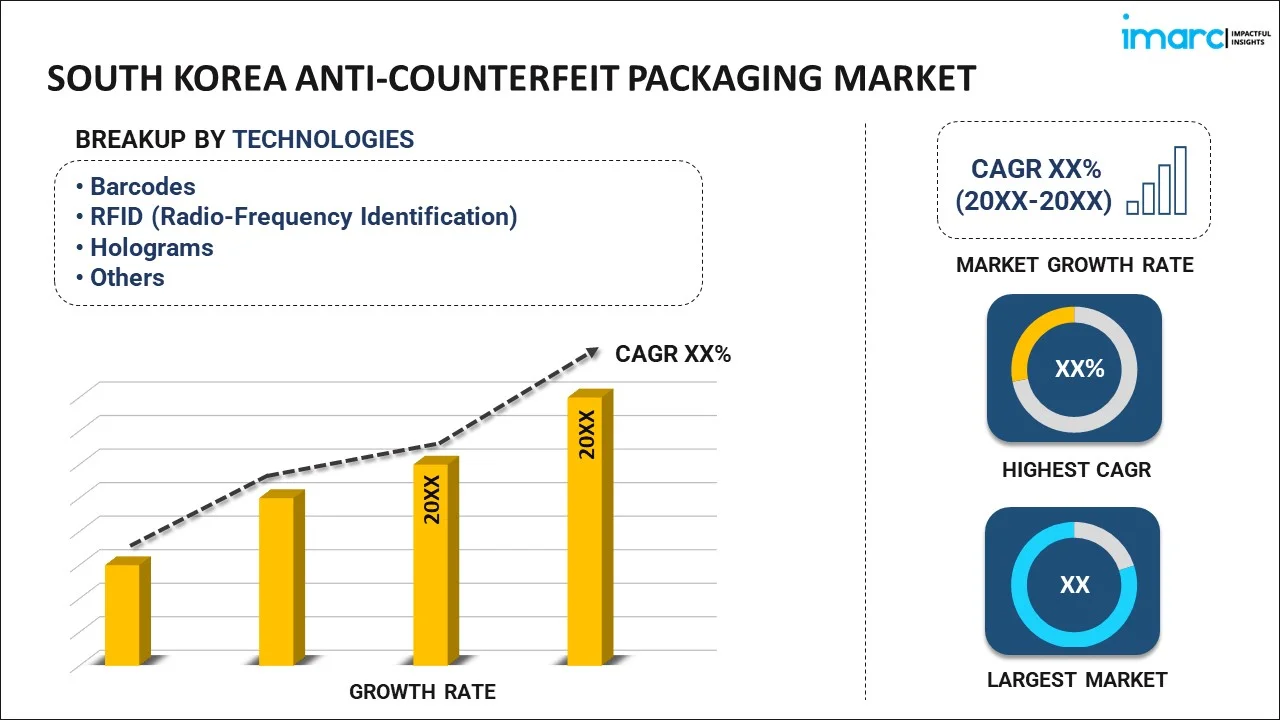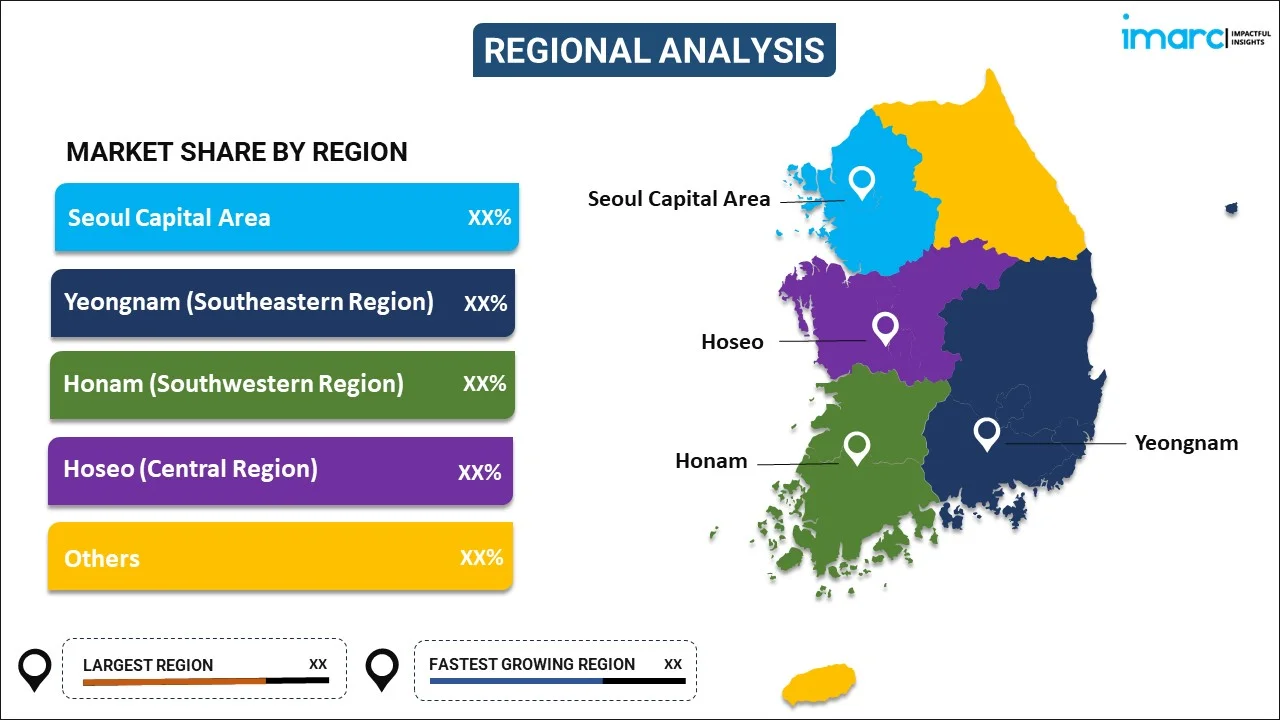
South Korea Anti-Counterfeit Packaging Market Report by Technology (Barcodes, RFID (Radio-Frequency Identification), Holograms, Taggants, and Others), Feature Type (Overt Features, Covert Features), End Use Industry (Food and Beverage, Healthcare, Automotive, Consumer Electronics, and Others), and Region 2024-2032
Market Overview:
The South Korea anti-counterfeit packaging market size is projected to exhibit a growth rate (CAGR) of 4.60% during 2024-2032. The stringent anti-counterfeit measures to maintain the integrity of products, rapid technological advancements, increasing consumer awareness, rising investments in online anti-counterfeit measures, emerging e-commerce industry, and protecting intellectual property to combat cross-border counterfeiting represent some of the key factors driving the market.
|
Report Attribute
|
Key Statistics
|
|---|---|
|
Base Year
|
2023 |
|
Forecast Years
|
2024-2032
|
|
Historical Years
|
2018-2023
|
| Market Growth Rate (2024-2032) | 4.60% |
Anti-counterfeit packaging is a critical component, primarily designed to protect products and consumers from the harmful effects of counterfeit goods. It encompasses various techniques, technologies, and materials employed to deter and identify counterfeit products. These measures help safeguard brand reputation, maintain consumer trust, and ensure the safety and authenticity of products. One of the most common anti-counterfeit packaging features is holograms, which are visually striking and challenging to replicate accurately. Another effective approach is QR codes or RFID tags that allow consumers to verify the authenticity of a product through their smartphones or other devices. Moreover, tamper-evident seals and unique serial numbers can serve as tangible indicators of authenticity, making it difficult for counterfeiters to replicate. These anti-counterfeit measures are essential across multiple industries, including pharmaceuticals, cosmetics, electronics, and luxury goods.
South Korea Anti-Counterfeit Packaging Market Trends:
South Korean consumers are becoming increasingly aware about the risks associated with counterfeit goods. High-profile cases of counterfeit products causing harm or financial losses have heightened consumer vigilance. As a result, consumers actively seek products with anti-counterfeit features and are willing to pay a premium for genuine goods. Additionally, various industries in South Korea collaborate to combat counterfeiting effectively. For instance, the pharmaceutical industry works closely with packaging companies to implement track-and-trace systems, ensuring the authenticity of medications. Similarly, the electronics and automotive sectors adopt sophisticated anti-counterfeit technologies to protect their products. Other than this, South Korea is a vital player in global supply chains, particularly in industries like electronics and automotive. The integration of South Korean manufacturers into global production networks necessitates stringent anti-counterfeit measures to maintain the integrity of products as they move across borders. This global perspective drives investment in anti-counterfeit solutions. Besides this, the rise of e-commerce in South Korea has created new challenges and opportunities in the fight against counterfeit products. Online marketplaces are fertile ground for counterfeiters; however, they also offer digital tools for product authentication. As a result, businesses are investing in online anti-counterfeit measures, such as digital watermarks and QR code verification. In line with this, South Korea places a strong emphasis on protecting intellectual property rights. This extends to international agreements and cooperation with other countries to combat cross-border counterfeiting. The commitment of nation to upholding intellectual property rights reinforces the importance of anti-counterfeit measures. Furthermore, South Korean brands are renowned globally for their quality and innovation. Moreover, protecting brand reputation is a significant driving force behind the adoption of anti-counterfeit technologies.
South Korea Anti-Counterfeit Packaging Market Segmentation:
IMARC Group provides an analysis of the key trends in each segment of the market, along with forecasts at the country level for 2024-2032. Our report has categorized the market based on technology, feature type, and end use industry.
Technology Insights:

- Barcodes
- RFID (Radio-Frequency Identification)
- Holograms
- Taggants
- Others
The report has provided a detailed breakup and analysis of the market based on the technology. This includes barcodes, RFID (radio-frequency identification), holograms, taggants, and others.
Feature Type Insights:
- Overt Features
- Covert Features
A detailed breakup and analysis of the market based on the feature type have also been provided in the report. This includes overt features and covert features.
End Use Industry Insights:
- Food and Beverage
- Healthcare
- Automotive
- Consumer Electronics
- Others
The report has provided a detailed breakup and analysis of the market based on the end use industry. This includes food and beverage, healthcare, automotive, consumer electronics, and others.
Regional Insights:

- Seoul Capital Area
- Yeongnam (Southeastern Region)
- Honam (Southwestern Region)
- Hoseo (Central Region)
- Others
The report has also provided a comprehensive analysis of all the major regional markets, which include Seoul Capital Area, Yeongnam (Southeastern Region), Honam (Southwestern Region), Hoseo (Central Region), and Others.
Competitive Landscape:
The market research report has also provided a comprehensive analysis of the competitive landscape. Competitive analysis such as market structure, key player positioning, top winning strategies, competitive dashboard, and company evaluation quadrant has been covered in the report. Also, detailed profiles of all major companies have been provided.
South Korea Anti-Counterfeit Packaging Market Report Coverage:
| Report Features | Details |
|---|---|
| Base Year of the Analysis | 2023 |
| Historical Period | 2018-2023 |
| Forecast Period | 2024-2032 |
| Units | US$ Million |
| Scope of the Report | Exploration of Historical and Forecast Trends, Industry Catalysts and Challenges, Segment-Wise Historical and Predictive Market Assessment:
|
| Technologies Covered | Barcodes, RFID (Radio-Frequency Identification), Holograms, Taggants, Others |
| Feature Types Covered | Overt Features, Covert Features |
| End Use Industries Covered | Food and Beverage, Healthcare, Automotive, Consumer Electronics, Others |
| Regions Covered | Seoul Capital Area, Yeongnam (Southeastern Region), Honam (Southwestern Region), Hoseo (Central Region), Others |
| Customization Scope | 10% Free Customization |
| Report Price and Purchase Option | Single User License: US$ 3699 Five User License: US$ 4699 Corporate License: US$ 5699 |
| Post-Sale Analyst Support | 10-12 Weeks |
| Delivery Format | PDF and Excel through Email (We can also provide the editable version of the report in PPT/Word format on special request) |
Key Questions Answered in This Report:
- How has the South Korea anti-counterfeit packaging market performed so far and how will it perform in the coming years?
- What has been the impact of COVID-19 on the South Korea anti-counterfeit packaging market?
- What is the breakup of the South Korea anti-counterfeit packaging market on the basis of technology?
- What is the breakup of the South Korea anti-counterfeit packaging market on the basis of feature type?
- What is the breakup of the South Korea anti-counterfeit packaging market on the basis of end use industry?
- What are the various stages in the value chain of the South Korea anti-counterfeit packaging market?
- What are the key driving factors and challenges in the South Korea anti-counterfeit packaging?
- What is the structure of the South Korea anti-counterfeit packaging market and who are the key players?
- What is the degree of competition in the South Korea anti-counterfeit packaging market?
Key Benefits for Stakeholders:
- IMARC’s industry report offers a comprehensive quantitative analysis of various market segments, historical and current market trends, market forecasts, and dynamics of the South Korea anti-counterfeit packaging market from 2018-2032.
- The research report provides the latest information on the market drivers, challenges, and opportunities in the South Korea anti-counterfeit packaging market.
- Porter's five forces analysis assist stakeholders in assessing the impact of new entrants, competitive rivalry, supplier power, buyer power, and the threat of substitution. It helps stakeholders to analyze the level of competition within the South Korea anti-counterfeit packaging industry and its attractiveness.
- Competitive landscape allows stakeholders to understand their competitive environment and provides an insight into the current positions of key players in the market.
Need more help?
- Speak to our experienced analysts for insights on the current market scenarios.
- Include additional segments and countries to customize the report as per your requirement.
- Gain an unparalleled competitive advantage in your domain by understanding how to utilize the report and positively impacting your operations and revenue.
- For further assistance, please connect with our analysts.
 Inquire Before Buying
Inquire Before Buying
 Speak to an Analyst
Speak to an Analyst
 Request Brochure
Request Brochure
 Request Customization
Request Customization




.webp)




.webp)












